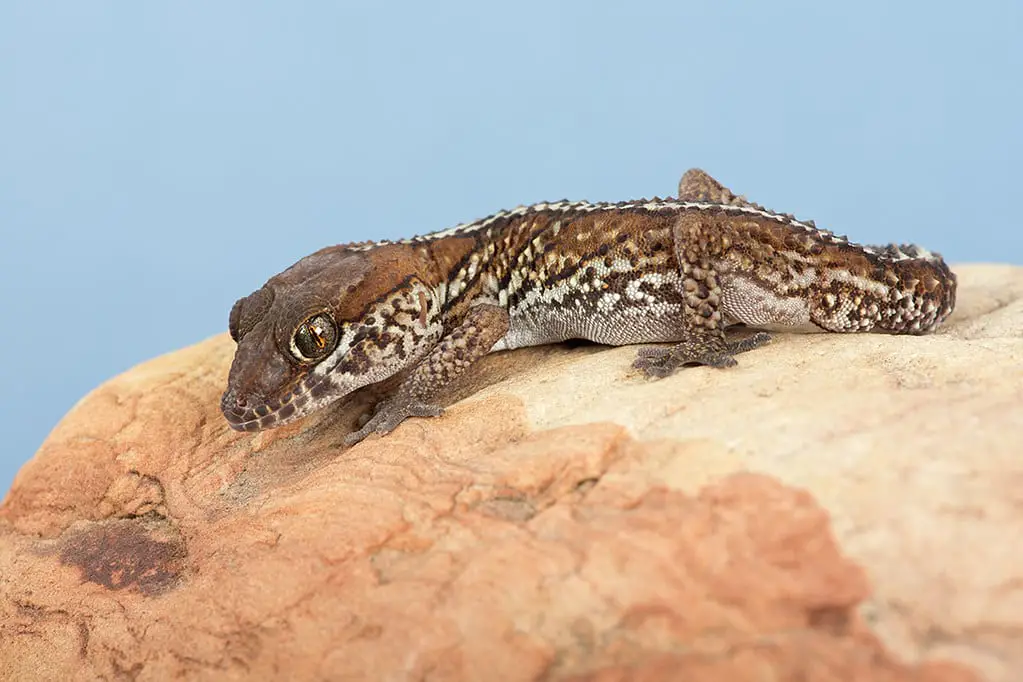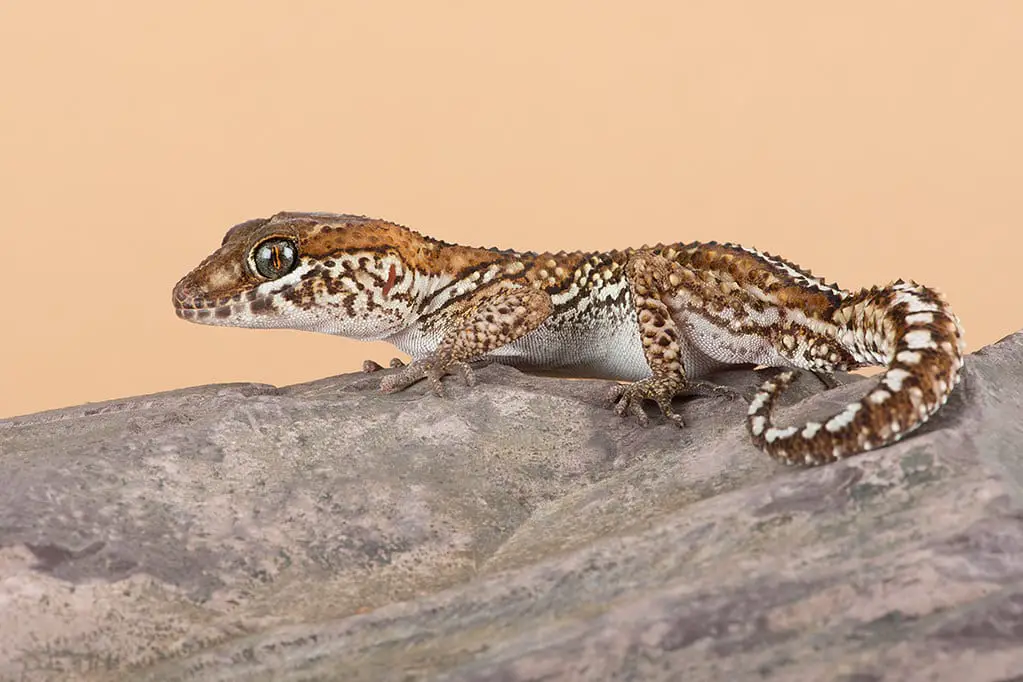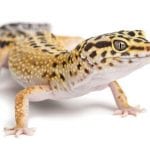Scientific Facts
| Common Name: | Madagascar Ground Gecko, ocelot gecko |
| Scientific Name: | Paroedura picta |
| Life Span: | In captivity from 6 to 10 years |
| Size: | 5 ½ inches in size with tail |
| Habitat: | Tropical, terrestrial |
| Country of Origin: | Madagascar |
Physical Description

Madagascar ground geckos are tropical and terrestrial geckos that have beautiful markings on their skin. It has large eyes and a medium to a small body that’s agile and able to adapt in almost all environments. This gecko is native to the southern part of Madagascar in east Africa. Because of its adorable appearance and interesting markings, it is one of the most popular lizard pets everywhere.
The Madagascar ground gecko is a good first lizard and also a precursor to people who have cared for other geckos like the Crested Gecko and the Leopard Gecko. These are wide-bodied geckos that have large heads and eyes.
Life Span
The three stages of growth of Madagascar Ground Geckos are as follows:
Hatchling
Hatchlings come out of their eggs after a long incubation period of 51 to 61 days. These hatchlings are very small but with already distinct features and colors.
Juvenile
Shortly after birth, Madagascar Ground Gecko young will grow, and hence there will be more capable of defending themselves from their common predators. Some breeders have seen that their juvenile geckos may eat other young or hatchlings of the same species.
Adult
Madagascar Ground Geckos mature after a brief amount of time; it’s ready to find a mate. There are some signs that a gecko is ready to mate, which we will discuss fully later. Males can mate with several females in the breeding season. Parents are responsible; they care for their young until these are mature to leave the nest.
Outside the mating season, Madagascar geckos may live with other lizards while some live alone. These can become aggressive when cornered. Madagascar Ground Geckos in rural homes are seen in gardens, ceilings, or walls, especially at night, looking for prey.
Eating Habits
In the wild, Madagascar Ground Geckos are hungry, smart predators and will eat insects such as super worms, crickets, waxworms, mealworms, and cockroaches. Meanwhile. Captive geckos have similar diets but may also be fed with warm pinky mice. Some expert owners gut the mice before these are given to the lizard. Juvenile Ground geckos should be fed once a day together with calcium supplements. Adults may be fed every other day.
Sleeping Habits
Madagascar Ground Geckos are nocturnal creatures, and they sleep in the morning and hunt prey in the evening. In the wild, these sleep in lairs, under barks of trees, and other small openings wherever it feels safe.
When kept at home, you should feed it in the evenings since it will sleep in the morning. Prepare a tank or cage with some soil and rocks where it can crawl in and sleep. Keep this place quiet in the mornings so it can sleep without any interruptions.
Water
Lizards like Madagascar Ground Geckos love shallow water to cool down and to take a drink. When preparing a tank or cage, place a small dish of water where it can drink. Water must be replaced daily. Geckos are maybe good swimmers, but deep water can drown them. To
Development and Reproduction
To find out the gender of your Madagascar Ground Gecko, you need to wait for 3 to 6 months. Males have prominent bulges called hemipenes, and these are found along the base of the tail. These are not present in females. Adult males are robust with larger heads, while females have smaller, slender bodies.
For breeding success, set up a breeding colony composing of one male to several females. A male will naturally breed and breed, so keep this gecko busy by placing many females.
A male will grab the female from behind the head during mating, and this usually leads to some injuries like minor wounds. These cuts will heal on its own, so don’t worry. But if the hold is too tight, this can kill the female due to severe injuries.
Use a humid hide where the female can lay eggs. A plastic container with enough moist soil would do. Place this at the back of the tank. You can use peat moss, sphagnum moss, coconut fiber, or vermiculite. Once the female has deposited her eggs, you can go ahead and take them. Incubate these in the damp substrate at 84 degrees Fahrenheit. The hatchlings will emerge around 65 days, and once these are out, they need to be fed ASAP.
Common Health Problems
Madagascar Ground Geckos may suffer from the following health conditions
Stomatitis
Similar to other lizards, lizards are prone to suffering from stomatitis or mouth rot. Common symptoms of stomatitis include redness and swelling along the mouth, pus, or cheese-looking discharge from the mouth. If you find excess saliva, then your pet might be suffering from a respiratory infection.
Parasitic Infections
Parasitic infections are also common. You can tell that the lizard has a skin infection when you spot a rash or inflamed skin. Geckos shed yearly. If your pet has difficulty shedding, then this could be another skin problem that should be resolved immediately.
Bites and other injuries
After a fight with another gecko, a Madagascar Ground Gecko may suffer from severe injuries, including the loss of a tail or limb. The lost tail will grow back, but it can take many days or weeks. The area may have cuts, marks, and severe injuries that may need immediate treatment.
For any severe injuries, take your Madagascar Ground Gecko to a vet to provide the necessary medical treatment. Your gecko can lose blood or can suffer from severe injuries if you overlook its condition.
Preventing Illness
To avoid illness, take your Madagascar Ground Gecko to a vet for a check-up and possible treatment. A vet can diagnose medical conditions and check for any nutrient problem which may affect your pet.
Separate males from each other. If you have more than one male, create a separate enclosure for each and, if possible, place their tanks or cages away from each other. And if you see a sick male or female, take this to the vet to prevent the spread of the illness and affect the rest of your pets.
For healthy geckos, use quality pet food. Pet owners use fresh food or organic food only. When it comes to supplements, ask your vet for a good brand. Finally, always make it a habit to clean your Madagascar Ground Gecko’s tank or cage. A dirty cage can lead to bacterial infections, parasites, and odors.
Behavior
To fully understand a Madagascar Ground Gecko, you need to learn all about its unique c behaviors. The Madagascar Ground Gecko is unique because of the following traits:
Nocturnal Pet
Ground geckos are nocturnal. They are active at night, hunt for food, defend their territory, and eat. Therefore, you must place its tank or cage in an area of your home where it’s quiet.
Bites Are Small But Dangerous
The bite of a Madagascar Ground Gecko is powerful; it can bite very hard insects and small prey. Its powerful bite also allows it to defend its area from other males and threats.
And if you want to remove a Madagascar Ground Gecko who has entered your home, call animal control service or any similar agency. You might end up with a nasty bite if you decide to handle the lizard on your own.
Very Territorial
Madagascar Ground Geckos are very territorial and will fight any gecko or any animal to defend its territory. It can fight hard for its space, and when it’s engaged in a fight, you can expect wounds and bruises in the end.
Lizards, like the Ground gecko, can bite the tail and the legs of their enemies. Their bites can injure their opponents until they lose a tail or a leg. But don’t worry about this because a ground gecko can grow his tailback.
A Madagascar Ground Gecko can even remove its own tail on purpose when it feels threatened when grabbed by the tail. It can take many weeks, though, especially when the gecko is older and has a larger body.
Good Climbers
Madagascar Ground Geckos are good climbers despite being called a Madagascar ground gecko.
Shedding
Madagascar Ground Geckos will shed their skin juvenile geckos will shed more often compared to adult lizards. This is because younger geckos will outgrow their skin. Usually, a healthy adult may shed their skin at least every month.
Shedding is complete in just 24 hours and maybe painful for geckos, especially when the tank temperature is too hot or too cold. A gecko is about to shed its skin when it is restless, and its eyes are white.
If you spot this, leave your gecko alone. And a few minutes before shedding their skin will look very pale. The skin will shed in fragments, and the ground gecko will eat their old skin. During the shedding phase, your pet may refuse to eat anything. This is natural, so you don’t need to worry. Make sure that there is enough food after they have shed. Leave food like mealworms, crickets, and other nutritious insects to build their energies after shedding.
Habitat
Madagascar Ground Geckos live happily on the floor and trees of the rainforests of Madagascar. It prefers to remain on land where insects and small animals abound.
Take note that a large tank is good for one gecko. Place one gecko inside each tank since these lizards are highly-territorial. Use another tank or cage where females can lay eggs and where hatchlings can remain.
Use potted plants to provide foliage or use plastic plants instead. Ground geckos love to sleep in crevices, holes, and wherever there’s any kind of cover. You can also place logs, tree barks, and large rocks so your gecko can sleep during the daytime. Place “hiding spots,” where it can be comfortable and sleep. These hides should be near the lamp or farther at the back of the tank.
The tank or cage must have a secure lid. Ground geckos are strong and may pop the lid open. An escaped gecko may become stressed, so always keep the lid of your gecko tank secure and locked.
Lighting and Humidity
You must keep your tank heated at 80 to 90 degrees Fahrenheit during the day and at 70 to 80 degrees Fahrenheit at night. Use an incandescent bulb for daytime heating and a reptile bulb or a ceramic bulb for nighttime heating.
Use a heating pad to provide tank heating. Maintain humidity levels at 70% by spraying the tank with water. Never allow the humidity to drop below 80%. A digital thermometer and hygrometer can help accurately check the temperature and humidity inside the tank.
Hydration
Place a heavy shallow dish of water inside its tank so that your Madagascar Ground Geckos may drink. Use a wide heavy bowl made of clay or porcelain so that it won’t be knocked over by your pet. Change this water regularly to prevent the growth of bacteria that can cause sickness.
Availability – Where to Get One?
Madagascar Ground Geckos are very popular pets and may be purchased from a local pet store or from an online pet shop. But due to conservation efforts, it may be very expensive to buy one. But despite this, Madagascar Ground Geckos cost around $50 or more depending on the size, gender, and age of the lizard. The color and the designs on the gecko’s skin can also affect its price in the market. But no matter what, you should only buy your pet ground gecko from a reputable pet shop or local dealer.
How to Care for a Madagascar Ground Gecko?
Here are some tips on how to care for a Madagascar Ground Gecko
- Keep the tank heated because Madagascar Ground Geckos cannot regulate body heat. Use a heating mat and an efficient lamp to provide comfortable heat inside the tank.
- Keep the tank humid by using a water sprayer and mist the inside of the tank often to maintain optimum humidity. Use a digital hygrometer to check for humidity levels.
- Always keep the tank clean. Remember that parasitic and bacterial infections of the skin and gut are usually due to dirty surroundings. Prevent these by keeping the gecko tank clean. Keep in mind that it can be hard to tell if your gecko is sick, so prevention is the best course of action.
- Leave the ground gecko alone when it’s shedding. Shedding is done every few weeks, and this can be very painful. But as much as you want to help it, it’s best to leave it alone. Shedding is a natural process, so don’t be worried. Leave a bowl of food after it is done shedding. It won’t eat, but after it has shed, it will be very hungry.
- Provide high protein food. Ground geckos require protein-rich food during the juvenile phase. Sneak in supplements by dusting insects and mice with supplements. Give your gecko a variety of foods so it can have a good appetite.
- Never place the tank in a high traffic area at home like your living room, kitchen, or playroom. Ground geckos are nocturnal animals and will appreciate it if you place it in a quiet area where it can sleep and recuperate. The basement is a good place to place a Ground gecko tank since this area is very quiet all day long.
- Remove males to save females since the female will continuously lay eggs, and this is not good for their health. She could end up dying in the hands of her mate if you don’t do something. So after laying two or three clutches, remove the male and place it inside another tank or cage.
- Never provoke your pet or else suffer a nasty bite. Handle it with care by using a thick glove if you’re new to handling a gecko. Have a comfortable hold, and don’t squeeze too hard so it won’t feel threatened. The more you handle your gecko, and you pick it up, the more it will feel more trusting and secure.
- Monitor the development of your pet by creating a diary of your pet’s growth and development. Use a measuring tape or ruler to easily measure your pet’s length. Use a small weighing scale to check the lizard’s weight. Observe changes in the skin, eye color, mouth color, and overall temperament. These could mean shedding or incomplete shedding.
- Take it to a vet for any emergency. Any medical problem should be consulted right away. A vet that specializes in reptile or exotic pet care would be the best option.
- Wash your hands after handling a Madagascar Ground Gecko because it can carry parasites and bacteria. Wash your hands with warm water and soap before and after handling your pet. This will also reduce the spread of any disease that your pet may have and to avoid contaminating your pet’s tank.
FAQ Section
What do Madagascar geckos eat?
Madagascar ground geckos are insectivorous. These should be fed with commercially-available insects and mealworms. Crickets should be 90% of the gecko’s head size, and younger geckos should be fed daily while older ones may be fed every other day.
Will Madagascar geckos make good pets?
Yes, these geckos can make good pets because these may be taken cared for in captivity and will eat commercially-prepared food.
Will geckos bite you?
Yes, geckos can bite, but only when it is threatened. If you are new to handling a gecko, be careful and don’t drop it or show that you are not capable because it can bite you when it’s afraid.
How do you feed a Madagascar ground gecko?
In captivity, place the mealworms inside the gecko’s cage in a shallow dish. The gecko will simply approach the bowl and take a bite of these worms. You may also release food inside and just let the gecko hunt it down, like in the wild.
Will geckos need water inside the tank?
Yes, it needs water to drink and water to improve humidity. It can get water by licking the dish where water is kept, or it can lick the tank walls and leaves.
Are geckos smart?
Yes, geckos are smart, and some owners say that their pets can recognize them and their voices. Geckos can follow their owners, as well.
Where do geckos sleep?
Geckos are nocturnal, and these will sleep in the mornings and be active at night. Usually, geckos eat, hunt, and look for food in the evening, and they also mate in the evenings as well.
How often do you need to feed a gecko?
Young geckos need to be fed daily with crickets and mealworms. As these mature, these can eat every other day. When sizing food for your gecko, use their heads to find out if the food can fit their mouths.
Can geckos live in cold areas?
Geckos will travel under the frost line to prevent freezing temperatures. Many species that live in cold areas build fat stores in their tails so that they can have nutrition during the cold months.
Is it possible to overfeed a gecko?
Yes, it is possible, but it rarely happens. Usually, geckos will stop eating after it is full, but some geckos after hibernation may eat or overeat. If you see this, remove food from their dishes and limit the feedings to every other day.
Can a gecko go a long time without eating?
Geckos can survive up to 2 weeks without eating. This is possible because it happens naturally during hibernation when the lizard remains in their dens without eating. Geckos that hibernate tend to eat more before hibernating to improve their fat stores in the tail. This fat is used as their food during hibernation.



